As we prepare for this holiday season, we are once again acquainted with the mechanics of product placement. We watch our favorite shows or see an influencer use a brand name product, maybe even say something about it. Then some combination of associating a product with good memories or just the mere exposure will get you to pick that product over something else you don’t know or have never heard anything about, even if what you had heard was just something brief. This “product” can also basically be anything. Entire lifestyles can be marketed this way to people which can, of course, lead to hundreds of purchasing decisions to fit that new trend. So it should come as no surprise at this point that we have become primed to having the entire concept of “holiday flowers” marketed to us.
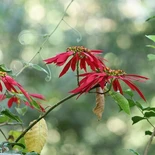
Poinsettia(Euphorbia pulcherrima)
The poinsettia, or more properly Euphorbia pulcherrima, is the dominant holiday flower across the entire United States. Contributing over $250 million dollars annually, it is one of the best selling potted plants in the country (Robin Sweetser, 2024). The story of the poinsettia and how it earned this position has nothing to do with the natural spread of seeds by animals or the wind over time, or how perfectly suited to the winter of North America it is, but everything to do with aggressive marketing. Vast swaths of commercial spaces are cleared to accommodate the growing of this tropical non native plant whose production displaces countless plants that are adapted to North America; native plants which don’t have to be constantly repurchased. To reconsider the holiday Poinsettia is to reconsider decades of programming, but will also lead to better landscapes and will prevent us all from wasting our time and money on something that, for a lot of us, couldn’t even survive outside during the holiday season.
Native to Central and South America, Euphorbia pulcherrima was first introduced in the 1800s by Joel Robert Poinsett. The flower went massively commercial through the later work of Paul Ecke Sr. in the early 1900s who, after taking a fancy to the plant while on vacation around Mexico, discovered a grafting technique that lead to fuller, bushier plants. Wild Euphorbia pulcherrima grows taller and much more gangly than we’re used to seeing on market shelves. It being a fairly unknown plant in North America, the connection to the holidays was only made possible through persistent donations made to Hollywood production studios, where the plant would then appear in the background of numerous TV shows like Bob Hope’s holiday special (Elaine Woo, 2002). The concept of a flower for the holidays was so new at the time that the only thing to compete with was a holly or maybe the yew, both shrubs.
Euphorbia pulcherrima is hardy to zone 9 at the minimum and blooms from November to January. This is pretty much the only coincidence with the holidays. Before USDA chemical controlled growth experiments, the picturesque leaves and stout form barely lingered for more than a month (Kim Kaplan, 2015). The modern cultivated iteration of Euphorbia pulcherrima is considerably different from what it even was in its native origins. Despite that, it doesn’t stand a chance in cold weather which is why for many people in North America this is a potted plant that stays indoors.
As far as ecological disruption goes, a potted plant seems pretty low on the list. Many people living in the South, however, can still plant this species outdoors with little issue. We should also be worried about the land space taken up by this plant (mostly in California) just dedicated to growing it for potted plant sales. Paul Ecke Ranch alone is over 1,000 acres, to say nothing of the many other greenhouses now able to grow this cultivar. I’m going to try to offer up some reasonable alternatives to the king of decorative flowers that hopefully rival its command of the holiday spirit.
Air plants (Tillandsia spp.)
An incredibly popular house plant about as generally accessible as a plant can get, the “air plant” has species native to Texas, Florida, and a few scattered among the Southeast. Considering how popular this plant already is it barely needs an introduction, but to elaborate on this potential Christmas connection I need to do some explaining.

Reflexed Airplant(Tillandsia baileyi)

Giant Airplant(Tillandsia fasciculata)

Small Ballmoss(Tillandsia recurvata)
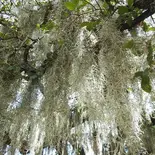
Spanish Moss(Tillandsia usneoides)
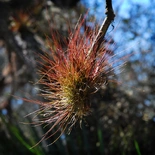
Southern Needleleaf(Tillandsia setacea)

Manatee River Airplant(Tillandsia simulata)
Tillandsia is a genus that belongs to the Bromeliaceae family which contains some other notable members like pineapple. It has a vibrantly colored inflorescence that on many species resemble a sort of red asparagus shoot and it attracts many types of insects for pollination. The flower protrudes from a dense rosette of thin green (often hairy) leaves. So in addition to the flower, the leaves can often turn red when given an abundance of sunlight or when well saturated with water. Much like the poinsettia, this green and red foliage combination gives it that Christmas tinge.
So you can look forward to the availability. It’ll be at nearly every big-box nursery (even if you are outside of its native range), and the bloom time might not always coincide with the holidays, but you have those leaf color changes to anticipate, and the caring requirements for this plant are negligible, as they don’t even need soil. As the common name implies, they collect water either from their trichomes, the leaf hairs, or by capturing water within the thicket of leaves.

American Witchhazel (Hamamelis virginiana)
There aren’t many flowers that bloom after November in the Northeast. Maybe they just get more snow over there? Regardless, Hamamelis is a very unique plant beyond being one of the only flowers blooming into January in the frozen North. It has important medicinal properties that were discovered by the Osage, Potawatomi, and other nations that found this three-to-seven meter shrub anywhere East of the Rocky Mountains. The water made from steam-distillation can be used on the skin to relieve irritations and is actually approved by the FDA as a drug ingredient (Andriote, 2012).
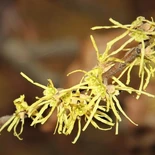
American Witchhazel(Hamamelis virginiana)
The flower itself is something worth scrutinizing. A branch will contain a scattering of these opposite growing short pedicel forms. Golden tissue paper streamers that lazily burst out of what can best be described as a cardboard box receptacle. A Christmas present of topical salve. The shrub is important for many insects that feed throughout the winter, and is particularly important as host for the Arconicta hamamelis, the “Witch Hazel Dagger Moth.”
Regarding the reason for the season, it lacks the green and red that we’ve so strongly associated with the holidays. But I believe we should forgive it for that on account of its unique standing among North American flowers. Unlike many flowers in Europe and Asia, few bloom this far into the Fall and Winter. It can grow outside from Maine to Florida and it can be found in most native plant nurseries.
Staghorn Sumac (Rhus typhina)
Though considered a nuisance shrub by many in the Northeast, Rhus typhina, the staghorn sumac is a native with a surprisingly tropical appearance. The numerous, naked, gangly, branches extend up over twenty feet that eventually branch off further with palm-like alternate leaves like a big scalp massager. At the very ends of the branches are these clumps of dark red hairy edible berries, almost like small fuzzy grapes. Although the leaves drop off around early November, the berry clumps persist for years. As they age they form this gentle dusty burgundy color that matches pretty well with a lot of the motifs that late season arrangements have. Since they are mostly dry to begin with before harvesting, they last quite a while indoors.
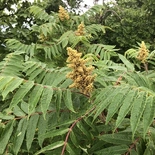
Staghorn Sumac(Rhus typhina)
The shrub is pretty ubiquitous among native plant nurseries that carry shrubs and trees. Its care requirements are low, assuming you plant it in its native range, which will be from Maine to West Virginia and as far West as Wisconsin; overall, a pretty small range. There are other species of Rhus that will extend this range and for all of them you will benefit many insects such as the Actias luna, an incredible moth. And if foraging for this plant in the wild, be sure to keep a lookout for the invasive “Tree of heaven,” Ailanthus altissima. It has a similar leaf growth pattern and the branching can be similar as well. The flowers will be a major giveaway, as well as lacking any sort of the velvet on the branches that the sumac is known for. Assuming you have permission, of course, remove this tree.
By Thanksgiving, the leaves will certainly drop, leaving you with the colors of brown and red. It won’t be the same as the poinsettia in that regard, but the longevity and edibility certainly makes up for this in my mind. Make an arrangement with some sumac berries, mix them in with Taxus canadensis and Ilex opaca and you’ve got that perfect Holiday bundle. No watering, no purchasing, no glitter.
Conclusion
Absence, I suppose, makes the heart grow fonder. In this case, fonder for blooming flowers. In the frozen North this is something pretty hard to come by. Maybe that’s why we’re willing to embrace something like the poinsettia so readily. But to see a plant so widespread and in places like Texas, where you can view natives like Hydrangea quercifolia all year-round? We must be suckers for good marketing.
Like a lot of iconic plants in Americas gardens, a fad appeared and took over rapidly, but since then nothing had ever really come to displace it. So much time had passed since the start of the fad that we just always assumed that it had to be this way and we forgot how it all started. The poinsettia was marketed as the “Holiday Flower” but we hadn’t been told what other options we had. Considering how many diverse climates and regions there are in the United States our options should be just as diverse. And as much as this story is about restoring the public image of native plant life, it is also a cautionary tale about chasing trends and following advertisements, especially at the cost of our ecosystem.
References
Andriote, J.M. (2012, November 6). The mysterious past and present of Witch Hazel. The Atlantic.
Los Angeles Times. (2002, May 16). Paul Ecke Jr., 76; made Poinsettia u.s.’ top-selling potted plant. Los Angeles Times.
Sweetser R. (2024). The legend of the poinsettia as a Christmas plant. Almanac.com.
USDA Blog “Poinsettias: Helping an icon to bloom at the right time”. USDA Blog RSS 2. (2015).

